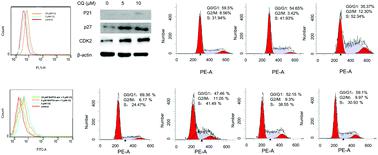当前位置:
X-MOL 学术
›
Metallomics
›
论文详情
Our official English website, www.x-mol.net, welcomes your
feedback! (Note: you will need to create a separate account there.)
Clioquinol induces S-phase cell cycle arrest through the elevation of the calcium level in human neurotypic SH-SY5Y cells.
Metallomics ( IF 2.9 ) Pub Date : 2019-11-01 , DOI: 10.1039/c9mt00260j Xiaoguang Lv 1 , Qiaoqiao Zheng , Ming Li , Zhiwei Huang , Min Peng , Jing Sun , Ping Shi
Metallomics ( IF 2.9 ) Pub Date : 2019-11-01 , DOI: 10.1039/c9mt00260j Xiaoguang Lv 1 , Qiaoqiao Zheng , Ming Li , Zhiwei Huang , Min Peng , Jing Sun , Ping Shi
Affiliation

|
Clioquinol is recently considered to be the most promising drug for treating cancer and neurodegenerative diseases. However, its mode of action varies from different disease models. In this study, we found that clioquinol inhibited cell growth in human neurotypic SHSY-5Y cells, which was attributed to both S-phase cell-cycle arrest and autophagic cell death. Clioquinol increased the intracellular contents of iron and zinc as well as calcium as measured by ICP-AES. Staining of Fluo-3 confirmed an increase in the level of calcium. Analysis of the metal-binding ability of clioquinol showed that it was not a chelating agent of calcium ions and the elevation of intracellular calcium content is not achieved by clioquinol as an ionophore. CaCl2 could simulate or even aggravate the cytotoxicity of clioquinol and it increased S-phase cell cycle arrest induced by clioquinol in a concentration dependent manner. Staining of acridine orange demonstrated that autophagy induced by clioquinol was not affected by addition of calcium ions. In contrast, the intracellular calcium ion chelator BAPTA-am abolished the clioquinol-induced S phase arrest and reduced the cell death caused by clioquinol. The WB assay of cell cycle-related proteins (CDK2, p21 and p27) further confirmed that S phase arrest is positively correlated with intracellular calcium elevation, which was due to the alterations of the mRNA and protein levels of calcium pumps (SERCA and SPCA). Taken together, these data indicate that clioquinol regulates the level of intracellular calcium ions to induce S-phase cell cycle arrest in human SH-SY5Y cells. Our results demonstrate for the first time that an increase of intracellular calcium content is one of the mechanisms of clioquinol in the inhibition of human neurotypic SHSY-5Y cells.
中文翻译:

在人类神经型SH-SY5Y细胞中,氯喹喹通过钙水平的升高诱导S期细胞周期停滞。
最近人们认为,喹诺酮酚是治疗癌症和神经退行性疾病的最有前途的药物。但是,其作用方式因疾病模型而异。在这项研究中,我们发现氯喹醇抑制人神经型SHSY-5Y细胞的细胞生长,这归因于S期细胞周期停滞和自噬细胞死亡。如ICP-AES所测定,氯喹诺尔增加了铁,锌以及钙的细胞内含量。Fluo-3染色证实了钙含量的增加。对氯喹啉的金属结合能力的分析表明,它不是钙离子的螯合剂,并且氯碘喹啉作为离子载体不能实现细胞内钙含量的增加。氯化钙2可以模拟甚至加重Clioquinol的细胞毒性,并以浓度依赖的方式增加Clioquinol诱导的S期细胞周期阻滞。cr啶橙的染色表明,氯喹醇诱导的自噬不受钙离子的影响。相反,细胞内钙离子螯合剂BAPTA-am消除了氯喹醇诱导的S期阻滞并减少了由氯喹醇引起的细胞死亡。细胞周期相关蛋白(CDK2,p21和p27)的WB分析进一步证实,S期停滞与细胞内钙升高呈正相关,这是由于钙泵(SERCA和SPCA)的mRNA和蛋白水平改变所致。在一起 这些数据表明,氯喹醇调节细胞内钙离子的水平以诱导人SH-SY5Y细胞中的S期细胞周期停滞。我们的结果首次证明,细胞内钙含量的增加是氯碘喹醇抑制人神经型SHSY-5Y细胞的机制之一。
更新日期:2019-11-01
中文翻译:

在人类神经型SH-SY5Y细胞中,氯喹喹通过钙水平的升高诱导S期细胞周期停滞。
最近人们认为,喹诺酮酚是治疗癌症和神经退行性疾病的最有前途的药物。但是,其作用方式因疾病模型而异。在这项研究中,我们发现氯喹醇抑制人神经型SHSY-5Y细胞的细胞生长,这归因于S期细胞周期停滞和自噬细胞死亡。如ICP-AES所测定,氯喹诺尔增加了铁,锌以及钙的细胞内含量。Fluo-3染色证实了钙含量的增加。对氯喹啉的金属结合能力的分析表明,它不是钙离子的螯合剂,并且氯碘喹啉作为离子载体不能实现细胞内钙含量的增加。氯化钙2可以模拟甚至加重Clioquinol的细胞毒性,并以浓度依赖的方式增加Clioquinol诱导的S期细胞周期阻滞。cr啶橙的染色表明,氯喹醇诱导的自噬不受钙离子的影响。相反,细胞内钙离子螯合剂BAPTA-am消除了氯喹醇诱导的S期阻滞并减少了由氯喹醇引起的细胞死亡。细胞周期相关蛋白(CDK2,p21和p27)的WB分析进一步证实,S期停滞与细胞内钙升高呈正相关,这是由于钙泵(SERCA和SPCA)的mRNA和蛋白水平改变所致。在一起 这些数据表明,氯喹醇调节细胞内钙离子的水平以诱导人SH-SY5Y细胞中的S期细胞周期停滞。我们的结果首次证明,细胞内钙含量的增加是氯碘喹醇抑制人神经型SHSY-5Y细胞的机制之一。











































 京公网安备 11010802027423号
京公网安备 11010802027423号